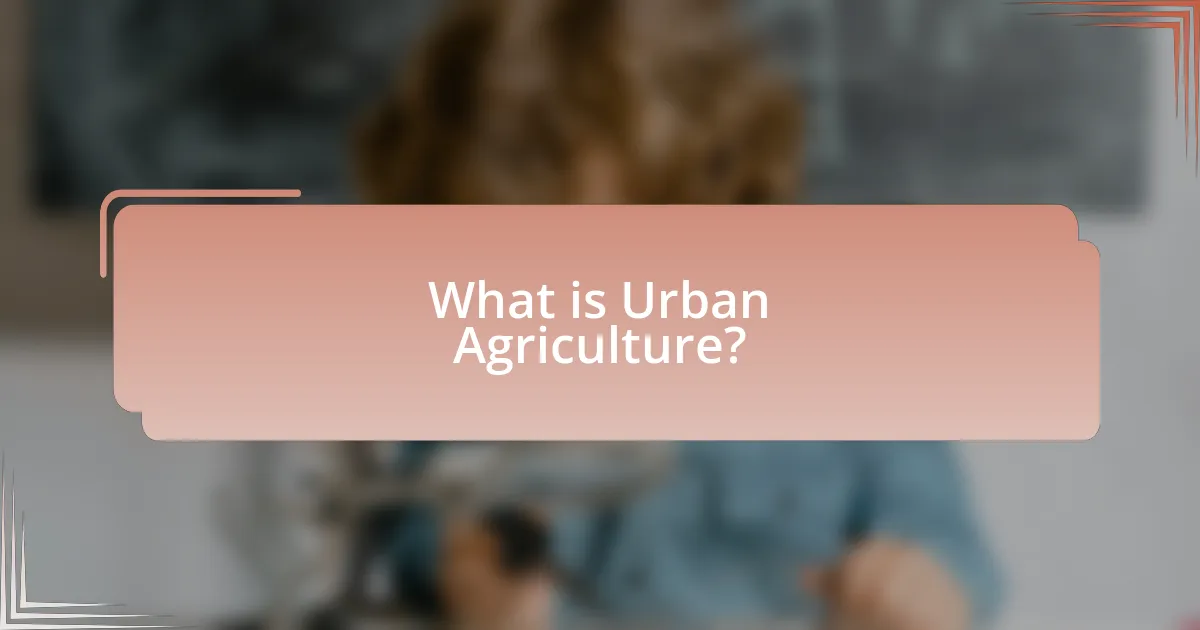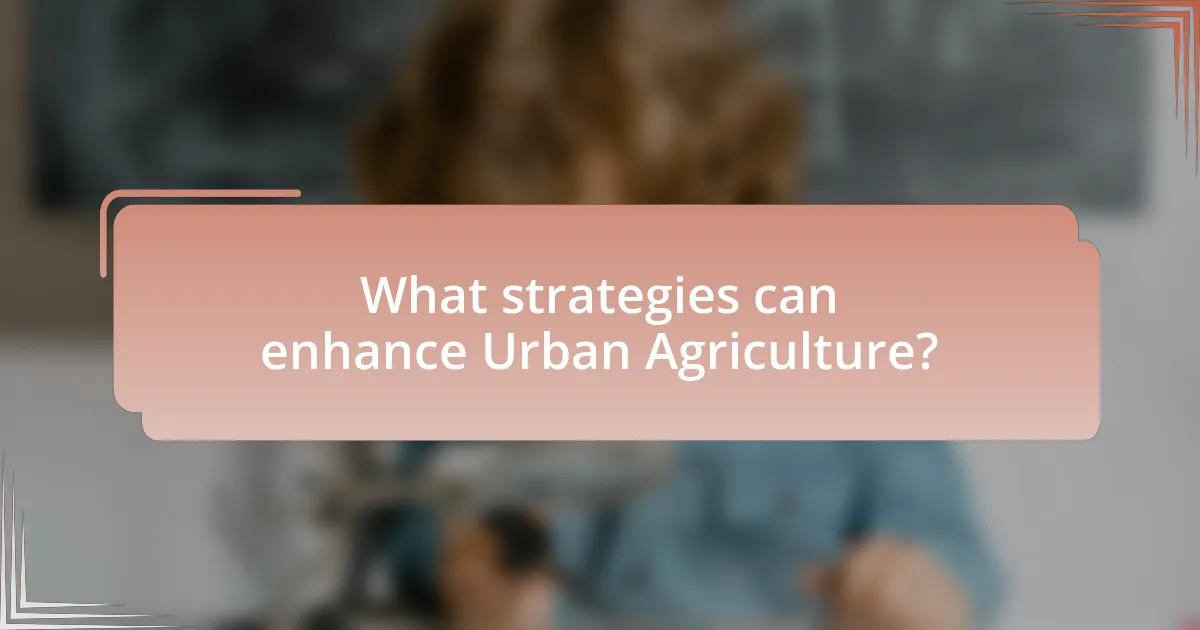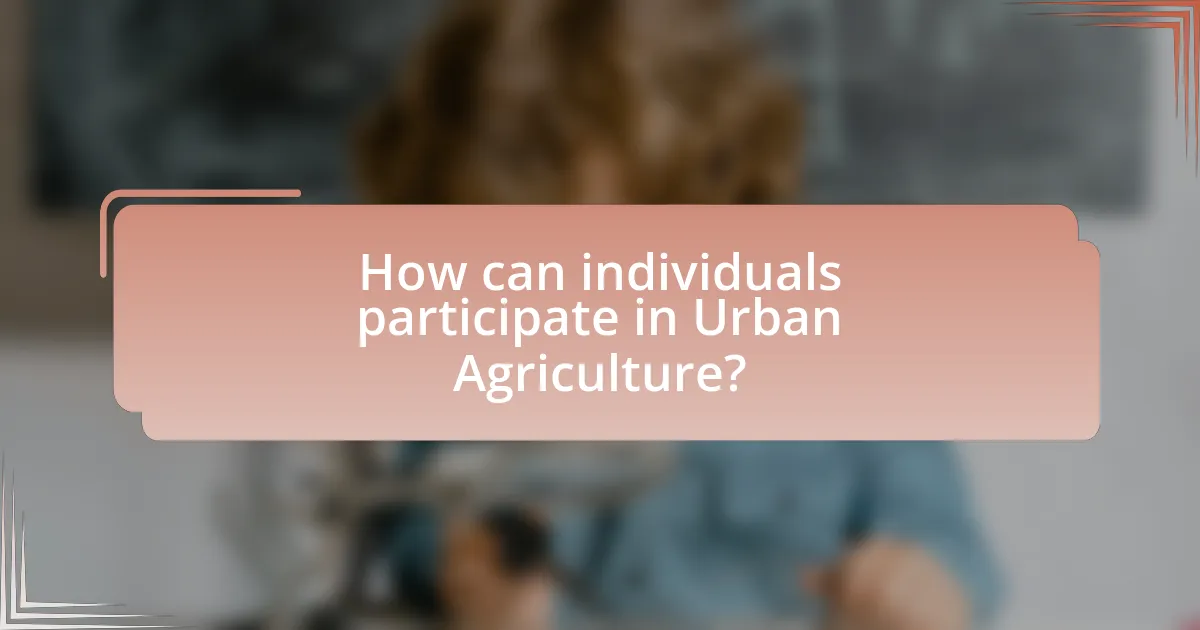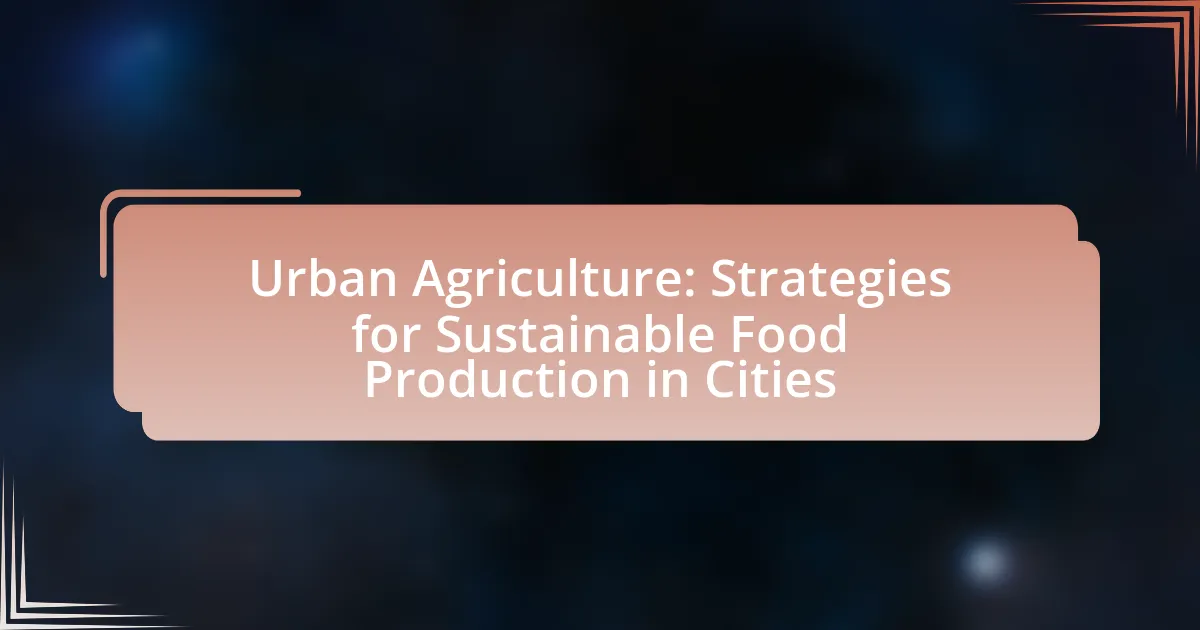Urban agriculture is the practice of cultivating, processing, and distributing food within urban areas, utilizing spaces such as rooftops and community gardens. This approach enhances food security by increasing local food production and reducing reliance on external sources, while also promoting sustainability through reduced transportation emissions and improved biodiversity. Key components of urban agriculture systems include land use, water management, crop selection, and community involvement, all of which contribute to their effectiveness. The article explores the environmental benefits, challenges, and innovative technologies associated with urban agriculture, as well as successful examples from around the world and strategies for enhancing urban farming initiatives.

What is Urban Agriculture?
Urban agriculture is the practice of cultivating, processing, and distributing food in or around urban areas. This approach integrates food production into the urban environment, utilizing spaces such as rooftops, community gardens, and vacant lots. According to the Food and Agriculture Organization (FAO), urban agriculture can enhance food security, improve access to fresh produce, and promote sustainable practices by reducing transportation emissions associated with food distribution.
How does Urban Agriculture contribute to food security?
Urban agriculture contributes to food security by increasing local food production, thereby reducing reliance on external food sources. This practice allows urban residents to grow fresh produce within city limits, which can lead to improved access to nutritious food. According to a study by the Food and Agriculture Organization, urban agriculture can enhance food availability by utilizing underused spaces, such as rooftops and vacant lots, to cultivate crops. Additionally, urban agriculture can strengthen community resilience by creating local food systems that are less vulnerable to global supply chain disruptions.
What are the key components of Urban Agriculture systems?
The key components of Urban Agriculture systems include land use, water management, crop selection, and community involvement. Land use refers to the allocation of urban spaces for agricultural activities, which can include rooftops, vacant lots, and community gardens. Water management involves the efficient use of water resources, often incorporating rainwater harvesting and irrigation systems to support plant growth. Crop selection focuses on choosing appropriate plants that can thrive in urban environments, often prioritizing fast-growing and high-yield varieties. Community involvement emphasizes the participation of local residents in planning, maintaining, and benefiting from urban agriculture initiatives, fostering a sense of ownership and sustainability. These components collectively contribute to the effectiveness and resilience of urban agriculture systems in enhancing food security and promoting sustainable practices in cities.
How do urban environments influence agricultural practices?
Urban environments influence agricultural practices by creating unique challenges and opportunities for food production. The presence of limited space, high population density, and varying land use in cities necessitates innovative approaches such as vertical farming, rooftop gardens, and community gardens. For instance, a study by the Food and Agriculture Organization (FAO) highlights that urban agriculture can enhance food security and reduce transportation costs, as food is grown closer to consumers. Additionally, urban environments often promote the use of sustainable practices, such as composting and rainwater harvesting, which are essential for efficient resource management in densely populated areas.
Why is Urban Agriculture important for sustainability?
Urban agriculture is important for sustainability because it enhances food security, reduces carbon footprints, and promotes biodiversity within urban environments. By allowing cities to produce food locally, urban agriculture minimizes the need for transportation, which significantly lowers greenhouse gas emissions associated with food distribution. According to a study by the Food and Agriculture Organization, urban agriculture can reduce food miles by up to 90%, contributing to a more sustainable food system. Additionally, urban farms can improve local ecosystems by providing habitats for pollinators and other wildlife, thereby increasing urban biodiversity. This integration of food production into urban planning supports sustainable development goals and fosters community resilience.
What environmental benefits does Urban Agriculture provide?
Urban agriculture provides significant environmental benefits, including improved air quality, enhanced biodiversity, and reduced urban heat islands. By incorporating plants into urban settings, urban agriculture helps absorb carbon dioxide and other pollutants, leading to cleaner air. Additionally, it creates habitats for various species, promoting biodiversity within city landscapes. Furthermore, urban agriculture can mitigate the urban heat island effect by increasing green cover, which lowers surrounding temperatures. Studies indicate that urban green spaces can reduce surface temperatures by up to 5 degrees Celsius, demonstrating the effectiveness of urban agriculture in creating more sustainable urban environments.
How does Urban Agriculture promote biodiversity?
Urban agriculture promotes biodiversity by creating diverse habitats within urban environments, which support various plant and animal species. This practice often incorporates a variety of crops, native plants, and pollinator-friendly species, enhancing ecological interactions. Research indicates that urban gardens can increase species richness; for instance, a study published in “Urban Ecosystems” found that community gardens in cities can host up to 50% more plant species compared to surrounding areas. Additionally, urban agriculture can mitigate habitat loss caused by urbanization, providing essential green spaces that contribute to the overall health of urban ecosystems.
What challenges does Urban Agriculture face?
Urban agriculture faces several significant challenges, including limited access to land, regulatory barriers, and resource constraints. Limited access to land arises from urbanization, where available space is often allocated for housing or commercial use, making it difficult for urban farmers to find suitable locations for cultivation. Regulatory barriers can include zoning laws that restrict agricultural activities in urban areas, complicating the establishment of urban farms. Additionally, resource constraints such as inadequate funding, lack of technical knowledge, and insufficient infrastructure further hinder the growth and sustainability of urban agriculture initiatives. These challenges collectively impact the ability of urban agriculture to contribute effectively to food security and community resilience in cities.
How do zoning laws affect Urban Agriculture initiatives?
Zoning laws significantly influence Urban Agriculture initiatives by dictating where agricultural activities can occur within urban areas. These regulations can either facilitate or hinder the establishment of community gardens, rooftop farms, and other agricultural projects based on land-use designations. For instance, in cities where zoning laws permit agricultural use in residential or commercial zones, Urban Agriculture can thrive, leading to increased local food production and community engagement. Conversely, restrictive zoning laws that classify urban land strictly for commercial or residential use can limit the ability to implement agricultural practices, thereby reducing access to fresh produce in urban settings. Studies have shown that cities with supportive zoning policies, such as Portland, Oregon, have seen a rise in urban farming initiatives, demonstrating the direct correlation between zoning regulations and the success of Urban Agriculture.
What are the economic barriers to implementing Urban Agriculture?
The economic barriers to implementing Urban Agriculture include high initial investment costs, limited access to funding, and market competition. High initial investment costs arise from the need for land acquisition, infrastructure development, and technology implementation, which can deter potential urban farmers. Limited access to funding is a significant barrier, as many urban agriculture projects struggle to secure financial support from banks or investors due to perceived risks and low profitability. Additionally, market competition from established agricultural producers can make it challenging for urban farms to sell their products at competitive prices, further complicating their economic viability. These factors collectively hinder the growth and sustainability of urban agriculture initiatives.

What strategies can enhance Urban Agriculture?
Implementing vertical farming is a key strategy to enhance urban agriculture, as it maximizes space utilization in densely populated areas. Vertical farms can produce up to 10 times more food per square foot compared to traditional farming methods, significantly increasing local food production. Additionally, integrating community gardens fosters local engagement and education about sustainable practices, which can lead to increased participation in urban agriculture initiatives. Research indicates that cities with community gardens see a 20% increase in community cohesion and food security. Utilizing hydroponics and aquaponics systems further optimizes resource use, reducing water consumption by up to 90% compared to conventional agriculture. These strategies collectively contribute to a more sustainable urban food system.
How can community engagement improve Urban Agriculture projects?
Community engagement can significantly improve Urban Agriculture projects by fostering collaboration, enhancing local knowledge, and increasing resource mobilization. Engaged communities contribute to the design and implementation of agricultural initiatives, ensuring that projects meet local needs and preferences. For instance, a study by the American Community Gardening Association found that community gardens not only provide fresh produce but also strengthen social ties and improve mental health among participants. Furthermore, when community members are actively involved, they are more likely to invest time and resources, leading to sustainable practices and increased project longevity. This collaborative approach also facilitates knowledge sharing, where local agricultural practices and cultural insights can be integrated into urban farming strategies, ultimately enhancing productivity and resilience in urban food systems.
What role do local governments play in supporting Urban Agriculture?
Local governments play a crucial role in supporting urban agriculture by implementing policies, providing resources, and facilitating community engagement. They create zoning regulations that allow for the establishment of community gardens and urban farms, which can enhance local food production. Additionally, local governments may offer grants or funding opportunities to support urban agriculture initiatives, as seen in cities like Detroit, where the city has allocated funds to promote urban farming. Furthermore, they can provide technical assistance and training programs to help residents develop agricultural skills, thereby fostering a sustainable food system within urban areas.
How can education and outreach programs foster Urban Agriculture?
Education and outreach programs can foster Urban Agriculture by providing essential knowledge and skills to community members, enabling them to engage in sustainable food production practices. These programs often include workshops, hands-on training, and resources that teach urban residents about gardening techniques, soil health, and crop selection tailored to urban environments. For instance, a study by the American Community Gardening Association found that community gardening initiatives significantly increase local food production and enhance community cohesion. By equipping individuals with practical skills and fostering a sense of community, education and outreach programs effectively promote the growth and sustainability of Urban Agriculture.
What innovative technologies are being used in Urban Agriculture?
Innovative technologies used in urban agriculture include vertical farming, hydroponics, aquaponics, and smart farming systems. Vertical farming utilizes stacked layers of crops in controlled environments, maximizing space and resource efficiency. Hydroponics involves growing plants in nutrient-rich water solutions, eliminating the need for soil and allowing for faster growth rates. Aquaponics combines fish farming with plant cultivation, creating a symbiotic environment that enhances productivity. Smart farming systems leverage IoT devices and data analytics to optimize resource use and monitor crop health, leading to increased yields and sustainability. These technologies collectively contribute to more efficient food production in urban settings, addressing challenges such as limited space and resource scarcity.
How does vertical farming contribute to Urban Agriculture?
Vertical farming significantly contributes to urban agriculture by enabling the efficient production of food in limited urban spaces. This method utilizes stacked layers of crops, often in controlled environments, which maximizes yield per square foot compared to traditional farming. For instance, vertical farms can produce up to 10 times more food than conventional farms on the same area, as reported by the National Academy of Sciences. Additionally, vertical farming reduces the need for transportation, as food can be grown closer to consumers, thereby decreasing carbon emissions associated with food transport. This localized production also enhances food security in urban areas, providing fresh produce directly to city dwellers.
What is the impact of hydroponics and aquaponics in urban settings?
Hydroponics and aquaponics significantly enhance urban agriculture by enabling efficient food production in limited spaces. These methods utilize soilless cultivation techniques, allowing for higher crop yields per square foot compared to traditional farming. For instance, hydroponic systems can produce up to 10 times more food than conventional farming in the same area, while aquaponics combines fish farming with plant cultivation, creating a symbiotic environment that maximizes resource use. Additionally, both systems reduce water consumption by up to 90% compared to traditional agriculture, addressing urban water scarcity issues. The integration of these technologies in cities contributes to food security, reduces transportation emissions, and promotes local economies by providing fresh produce directly to urban populations.
What are successful examples of Urban Agriculture around the world?
Successful examples of urban agriculture around the world include the Rooftop Gardens in New York City, which utilize over 600 rooftops to grow food, contributing to local food security and reducing urban heat. Another notable example is the Urban Agriculture Initiative in Havana, Cuba, where community gardens have transformed vacant lots into productive spaces, providing food for residents and promoting self-sufficiency. Additionally, the Vertical Farm project in Singapore showcases innovative farming techniques in limited spaces, producing high yields of vegetables while minimizing land use. These examples demonstrate the effectiveness of urban agriculture in enhancing food production and sustainability in urban environments.
How have cities like Detroit and Singapore implemented Urban Agriculture?
Cities like Detroit and Singapore have implemented urban agriculture through innovative strategies tailored to their unique environments. In Detroit, the city has transformed vacant lots into community gardens and urban farms, supported by initiatives like the Detroit Urban Agriculture Ordinance, which encourages local food production and provides resources for urban farmers. This approach has led to the establishment of over 1,500 urban farms and gardens, contributing to food security and community revitalization.
In Singapore, urban agriculture is integrated into the city’s landscape through vertical farms and rooftop gardens, supported by government policies that promote sustainable food production. The Agri-Food & Veterinary Authority of Singapore has launched initiatives like the “30 by 30” goal, aiming to produce 30% of nutritional needs locally by 2030. This has resulted in the development of high-tech farming solutions, such as indoor farms that utilize hydroponics and aeroponics, maximizing space and efficiency in a densely populated urban area.
What lessons can be learned from international Urban Agriculture initiatives?
International Urban Agriculture initiatives demonstrate the importance of community engagement and collaboration in enhancing food security. These initiatives often involve local residents in the planning and implementation processes, fostering a sense of ownership and responsibility. For instance, the urban farming project in Detroit, Michigan, has shown that involving community members leads to increased participation and better outcomes in food production. Additionally, successful initiatives highlight the need for supportive policies and infrastructure, as seen in cities like Havana, Cuba, where government support for urban gardens has significantly improved access to fresh produce. Furthermore, these initiatives reveal the potential for urban agriculture to contribute to environmental sustainability by promoting biodiversity and reducing urban heat islands, as evidenced by the green roofs and vertical gardens implemented in cities like Singapore.

How can individuals participate in Urban Agriculture?
Individuals can participate in urban agriculture by engaging in community gardens, rooftop farming, or home gardening. Community gardens allow residents to cultivate crops collectively, fostering community ties and providing access to fresh produce. Rooftop farming utilizes underused urban spaces, contributing to local food systems and reducing urban heat. Home gardening enables individuals to grow their own food, promoting self-sufficiency and sustainability. According to the American Community Gardening Association, community gardens can increase access to fresh fruits and vegetables, improve neighborhood aesthetics, and enhance social interaction among residents.
What are the different types of Urban Agriculture that individuals can engage in?
Individuals can engage in several types of urban agriculture, including community gardens, rooftop gardens, vertical farming, hydroponics, aquaponics, and urban beekeeping. Community gardens allow residents to cultivate shared plots, fostering community engagement and food production. Rooftop gardens utilize unused rooftop space for growing food, contributing to urban greening and insulation. Vertical farming maximizes space by growing crops in stacked layers, often using controlled environments to enhance yield. Hydroponics involves growing plants in nutrient-rich water without soil, while aquaponics combines fish farming with hydroponics, creating a symbiotic environment. Urban beekeeping supports pollination and honey production, contributing to biodiversity in urban settings. These methods collectively enhance food security, promote sustainability, and utilize limited urban space effectively.
How can community gardens be established in urban areas?
Community gardens can be established in urban areas by identifying suitable vacant land, securing permissions from landowners or local authorities, and engaging the community in the planning and maintenance process. Research indicates that urban community gardens can enhance food security, improve mental health, and foster social connections among residents. For instance, a study published in the Journal of Urban Agriculture and Regional Food Systems highlights that community gardens in cities can increase access to fresh produce and promote community engagement, demonstrating their effectiveness in urban settings.
What resources are available for urban farmers?
Urban farmers have access to various resources including community gardens, agricultural extension services, urban farming organizations, and online platforms for knowledge sharing. Community gardens provide shared spaces for growing food, while agricultural extension services offer expert advice and support tailored to urban settings. Organizations such as the Urban Agriculture Coalition and the American Community Gardening Association provide networking opportunities and resources for urban farmers. Additionally, online platforms like the USDA’s Urban Agriculture Toolkit offer guidelines and best practices for urban farming, enhancing the capacity of urban farmers to produce food sustainably in cities.
What best practices should be followed in Urban Agriculture?
Best practices in urban agriculture include selecting appropriate crops, utilizing sustainable practices, and engaging the community. Selecting crops that are well-suited to the local climate and soil conditions enhances yield and reduces resource use. Sustainable practices, such as organic farming, permaculture, and integrated pest management, minimize environmental impact and promote biodiversity. Engaging the community fosters support and participation, which can lead to shared resources and knowledge. Research indicates that urban agriculture can improve food security and community resilience, as evidenced by studies showing increased access to fresh produce in urban areas.
How can urban farmers ensure sustainable practices?
Urban farmers can ensure sustainable practices by implementing techniques such as crop rotation, organic pest management, and water conservation methods. Crop rotation enhances soil health and reduces pest buildup, while organic pest management minimizes chemical use, promoting biodiversity. Water conservation techniques, such as rainwater harvesting and drip irrigation, optimize water usage, crucial in urban settings where resources may be limited. According to a study published in the Journal of Urban Agriculture, these practices not only improve yield but also contribute to the resilience of urban ecosystems, demonstrating their effectiveness in sustainable urban farming.
What are common pitfalls to avoid in Urban Agriculture?
Common pitfalls to avoid in urban agriculture include inadequate planning, poor site selection, and neglecting community engagement. Inadequate planning can lead to inefficient use of space and resources, resulting in lower yields. Poor site selection, such as choosing locations with contaminated soil or insufficient sunlight, can hinder plant growth and productivity. Neglecting community engagement can result in a lack of support and participation, which is crucial for the sustainability of urban agriculture projects. Research indicates that successful urban agriculture initiatives often involve thorough planning, careful site assessment, and active community involvement to ensure long-term viability and productivity.
What are the future trends in Urban Agriculture?
Future trends in urban agriculture include the rise of vertical farming, increased use of technology such as hydroponics and aquaponics, and a focus on sustainability through local food systems. Vertical farming allows for efficient land use in densely populated areas, with projections indicating that the global vertical farming market could reach $12.77 billion by 2026. Technology integration enhances crop yields and reduces resource consumption, with hydroponic systems using up to 90% less water than traditional farming. Additionally, urban agriculture is increasingly recognized for its role in reducing food miles and carbon footprints, contributing to urban resilience and food security.
How will climate change impact Urban Agriculture practices?
Climate change will significantly impact urban agriculture practices by altering growing conditions, increasing pest and disease pressures, and affecting water availability. As temperatures rise and weather patterns become more erratic, urban farmers may face challenges such as heat stress on crops and reduced yields. For instance, a study published in the journal “Agricultural Systems” indicates that climate change could reduce crop yields by up to 30% in some urban areas by 2050 due to increased temperatures and changing precipitation patterns. Additionally, urban agriculture will likely need to adapt to more frequent extreme weather events, such as floods and droughts, which can disrupt food production and supply chains. These changes necessitate the adoption of resilient agricultural practices, such as drought-resistant crops and improved water management strategies, to sustain urban food systems in the face of climate change.
What role will technology play in the future of Urban Agriculture?
Technology will play a crucial role in the future of Urban Agriculture by enhancing efficiency, productivity, and sustainability. Innovations such as vertical farming, hydroponics, and aquaponics allow for space-efficient food production in urban settings, significantly reducing land use and water consumption. For instance, vertical farms can produce up to 10 times more food per square foot compared to traditional farming methods, while using 90% less water. Additionally, smart agriculture technologies, including IoT sensors and data analytics, enable real-time monitoring of crop health and resource usage, optimizing yields and minimizing waste. These advancements not only address food security in urban areas but also contribute to reducing the carbon footprint associated with food transportation.

